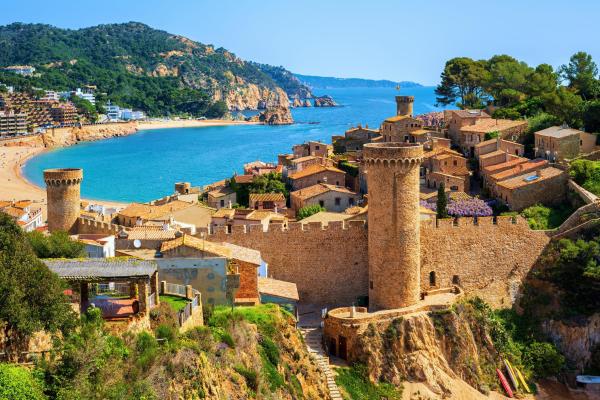
Catalonia is one of the autonomous communities that make up Spain. Each has their own flag that represents the population. In the case of the Catalan flag, they have a red and yellow striped banner known as La Senyera. It is one of the main national symbols of the region. Its history is linked to a medieval legend which holds a special place in the area.
As with the Catalan language, the flag is another element that serves to identify and represent the population of Catalonia. The Senyera is an element of union of their territories. Due to its great symbolism, it is important to know its history and origins. This is why oneHOWTO looks into the Catalan flag history and meaning.
What is Catalonia and where is it located?
Before we look specifically at La Senyera, we discover a little background about one of the most beautiful and well-known parts of Spain:
- Catalonia is an autonomous community located in the northeast of Spain with a land area covering 32,107 km2. It borders the Mediterranean Sea to the East, France and Andorra to the North, Aragon to the West and the Valencian Community to the South.
- It has almost 580 kilometers of coastline. It also has large relief areas such as the Pyrenees and Pre-Pyrenees, the Catalan Central Depression and the Sierra Transversal. These geographical elements make the climate of Catalonia variable depending on the territory.
- You can find a Mediterranean climate on the Catalan coast (hot in summer and mild in winter), a continental climate in the interior (very hot summers and cold winters) and a high mountain climate in the north (mild temperatures in summer and snow in winter).
- Currently, Catalonia has more than 7 million inhabitants who are divided into 946 municipalities. It has two administrative forms for its territorial division. These are the Administration division (41 counties) and the administrative division at state level, with four provinces. These provinces are Barcelona, Girona, Tarragona and Lleida. The city of Barcelona is the Catalan capital.
- Catalan culture and society have been built based on the exchange of ideas, people and customs. It is the result of a long history of commercial transactions with other nations and cultures, thanks to its position as an enclave in the Mediterranean. This is also why it is a hub for migration.
- Catalonia enjoys deep-rooted consideration by its institutions, its language (Catalan), culture and traditions. Catalan language is a fundamental element of Catalan identity and an essential factor for social cohesion. Hence its importance for any newcomer to learn the Catalan language, being able to communicate in this way through the language of the host territory.

History of the flag of Catalonia
Now we know a little background on Catalonia, we can learn more specific about the history of the Catalan flag:
- The first representation of the Senyera in the form of four bars or stripes as a heraldic symbol of the coat of arms of the house of Barcelona is found in the tombs of Count Ramón Berenguer II and Countess Ermessenda, buried in the Cathedral of Girona.
- Despite the fact the number of stripes that accompany the tombs is greater than 4, the representation of the shield, which contains red stripes on a yellow background, is an unequivocal symbol of the representation at that time of the Barcelona house with this symbology.
- The number of red bars specified to four is found in a wax seal corresponding to Count Ramón Berenguer IV, dated 1150. From that moment on, the symbol of the Catalan flag acquires its current appearance, repeating itself in subsequent coats of arms.
- In the 14th century, King Pedro the Ceremonious (known in Catalan as Pere el Cerimoniós) ordered that the shield with the four bars become the heraldic symbol of the dynasty. In this way, over the centuries, it developed into becoming a symbol of Catalonia's identity.
- The Senyera was known as the flag of Catalonia since the 14th century, but it was not claimed as a national symbol until the 19th century. At that time, the Renaixença Catalanist movement took it as the national flag of Catalonia. Since then, successive governments of both the Mancomunitat de Catalunya and the Generalitat de Catalunya have used it as their official flag.
- The Senyera was outlawed during the Spanish dictatorships of Primo de Rivera and General Francisco Franco. The flag of Catalonia was persecuted for being considered a symbol of Catalan identity, and its display was prohibited until 1979, when modern democracy was established.
- Currently, the Senyera is displayed during the Diada Nacional de Catalunya, the Catalan national holiday that is celebrated on September 11.

What does the flag of Catalonia mean?
The flag of Catalonia has the meaning of representing the Catalan people. It unites all the territories and is one of its main symbols, both for people born in its land and for those it hosts. Under the flag, all the identifying elements of Catalan society and culture are represented.
The Senyera is one of the identity symbols of Catalonia along with other elements such as the Catalan language. Its origin comes from the year 1150, specifically from the heraldic symbol of the lineage corresponding to the counts of Barcelona.
Learn more about Catalan culture by looking at one of its most cherished components, i.e. the typical Catalan dishes of the region.
If you want to read similar articles to The Catalan Flag History and Meaning, we recommend you visit our Learning category.